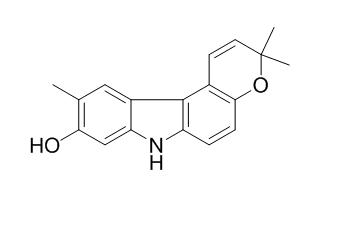Glycoborinine
Glycoborinine is a potential molecule against cancer cells, it can induce HepG2 apoptosis through the mitochondrial-dependent pathway. Glycoborinine has photo-activated antimicrobial activity, it shows moderate inhibition on Nde I, Xba I, Nco I and Bcl I.
Inquire / Order:
manager@chemfaces.com
Technical Inquiries:
service@chemfaces.com
Tel:
+86-27-84237783
Fax:
+86-27-84254680
Address:
1 Building, No. 83, CheCheng Rd., Wuhan Economic and Technological Development Zone, Wuhan, Hubei 430056, PRC
Providing storage is as stated on the product vial and the vial is kept tightly sealed, the product can be stored for up to
24 months(2-8C).
Wherever possible, you should prepare and use solutions on the same day. However, if you need to make up stock solutions in advance, we recommend that you store the solution as aliquots in tightly sealed vials at -20C. Generally, these will be useable for up to two weeks. Before use, and prior to opening the vial we recommend that you allow your product to equilibrate to room temperature for at least 1 hour.
Need more advice on solubility, usage and handling? Please email to: service@chemfaces.com
The packaging of the product may have turned upside down during transportation, resulting in the natural compounds adhering to the neck or cap of the vial. take the vial out of its packaging and gently shake to let the compounds fall to the bottom of the vial. for liquid products, centrifuge at 200-500 RPM to gather the liquid at the bottom of the vial. try to avoid loss or contamination during handling.
Anal Sci.2019, 35(12):1317-1325
The Thai Journal of Pharmaceutical Sciences2023, 47(3):3.
Front Microbiol.2021, 12:736780.
Biochem Pharmacol.2023, 211:115502.
Food Hydrocolloids2024, 156:110345
Phytochemistry2018, 15:83-92
J Nat Med.2018, 72(3):734-744
Am J Chin Med.2023, 51(4):1019-1039.
Fitoterapia.2022, 105141.
Korean Journal of Pharmacognosy2019, 50(4):285-290
Related and Featured Products
Yao Xue Xue Bao. 2012 Dec;47(12):1646-52.
Photo-activated DNA binding and antimicrobial activities of alkaloids from Glycosmis pentaphylla.[Pubmed:
23460971]
In our screening for photosensitizers from natural resources, four
METHODS AND RESULTS:
alkaloids were isolated from Glycosmis pentaphylla by various chromatography techniques.Their structures were identified as Glycoborinine (1), glybomine B (2), carbalexin A (3) and N-p-coumaroyltyramine (4) by spectral analysis. Their photoactivated antimicrobial activities were evaluated by thin-layer chromatography (TLC) agar overlay assay against Staphylococcus aureus and Bacillus subtilis. It was found that compounds 1 and 4 showed photo-activated antimicrobial activities. Meantime, photo-activated DNA binding activities of these compounds were also assessed by using a specially prepared 1.8 kb DNA fragment and restriction enzymes.
CONCLUSIONS:
Under UVA irradiation, compound 1 showed moderate inhibition on Nde I, Xba I, Nco I and Bcl I which have either 5'-TpA or 5'-ApT and trace or no inhibition on other restriction enzymes. It showed a similar inhibition pattern with the reference 8-methoxypsoralen. However, compounds 2-4 showed no inhibition against any of the restriction enzymes.
J Asian Nat Prod Res. 2014 Oct;16(10):991-9
Glycoborinine induces apoptosis through mitochondrial pathway in HepG2 cells.[Pubmed:
24930917]
Glycoborinine (GB), a natural carbazole alkaloid isolated from Glycosmis pentaphylla, has been shown to be a potential molecule against cancer cells.
METHODS AND RESULTS:
In this study, the cell-signaling pathway of its anti-tumor activity was investigated. MTT assay result showed that GB inhibited HepG2 cell proliferation in a dose- and time-dependent manner and 50% inhibiting concentration (IC50) of GB-induced cell death was 39.7 μM for a period of 48 h. GB-induced HepG2 apoptosis was confirmed by Hochest 33258 staining and PI staining. The level of reactive oxygen species (ROS) was measured with H2DCF-DA staining and the change of mitochondrial membrane potential (△Ψ(m)) was analyzed with tetrechloro-tetraethylbenzimidazolcarbocyanine iodide (JC-1) probe. Results showed that GB at 12.5, 25, and 50 μM promoted ROS production. GB induced HepG2 apoptosis through a mitochondrial apoptotic pathway, which was demonstrated by GB-induced increase in the ratio of Bax/Bcl-2, cytochrome C release, the ratio of cleaved caspase-3/procaspase-3, and the ratio of cleaved poly ADP-ribose polymerase (cleaved PARP)/poly ADP-ribose polymerase (PARP).
CONCLUSIONS:
To summarize, this study demonstrated that GB could induce HepG2 apoptosis through the mitochondrial-dependent pathway, which might provide a promising approach to cure liver cancer with GB.



